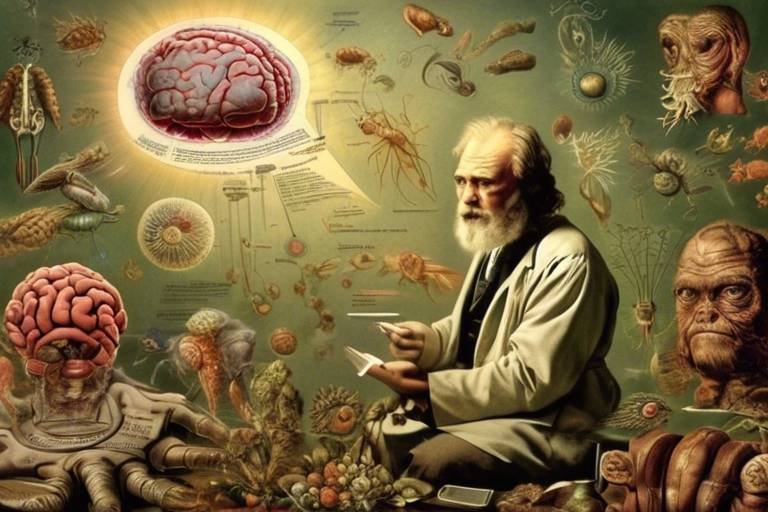Does the Biotic Interaction Have Philosophical Implications?
When we think about the intricate web of life that surrounds us, it becomes clear that biotic interactions—the relationships between living organisms—are not just mere biological phenomena; they are deeply woven into the fabric of our philosophical understanding of existence. These interactions, which encompass everything from predation and competition to symbiosis, challenge us to reconsider our place in the world and our ethical responsibilities toward other beings. Have you ever wondered how the simple act of a bee pollinating a flower extends beyond biology to touch on issues of morality and existence? This article explores these fascinating dimensions, revealing how our interactions with the living world can lead to profound philosophical inquiries.
At the core of biotic interactions is the idea that life is interconnected. Every organism, whether it’s a towering oak tree or a microscopic bacterium, plays a role in sustaining the ecosystem. This interconnectedness prompts us to ask big questions: What does it mean to exist? How do our actions affect the broader web of life? When we observe the delicate balance of an ecosystem, we can’t help but reflect on the ethical implications of our choices. Are we stewards of the Earth, or are we merely passersby, indifferent to the lives we impact? These questions are not just academic; they shape our policies, our conservation efforts, and our day-to-day interactions with the world around us.
As we dive deeper into the philosophical perspectives surrounding biotic interactions, we encounter various frameworks that offer unique insights. Existentialism, for instance, encourages us to confront the absurdity of life and to find meaning in our relationships with others, including non-human entities. Biocentrism, on the other hand, posits that all living beings have intrinsic value, challenging the anthropocentric views that often dominate our thinking. Furthermore, eco-phenomenology invites us to experience the world through the lens of our bodily existence, emphasizing the importance of our sensory interactions with the environment. Each of these philosophies enriches our understanding of biotic interactions, urging us to consider not just the biological, but also the ethical and existential dimensions of life.
In exploring the ethical considerations inherent in biotic relationships, we find ourselves at a crossroads. The traditional human-centered ethics often overlook the moral significance of other living beings. This brings us to the concept of biocentric ethics, which advocates for recognizing the intrinsic value of all life forms. Imagine a world where every creature, from the smallest insect to the largest mammal, is regarded as having a right to exist. This perspective challenges us to rethink our decision-making processes, urging us to consider the impact of our actions on the entire web of life.
Moreover, the intersection of ecology and feminism in ecofeminism provides another layer of understanding. It examines how gender dynamics influence our interactions with the environment and advocates for a more inclusive approach to ethics. By recognizing the interconnectedness of social and ecological issues, ecofeminism calls for a holistic understanding of life that transcends traditional boundaries. This perspective not only enriches our philosophical discourse but also empowers us to take action in preserving the delicate balance of our ecosystems.
As we delve into the epistemological implications of biotic interactions, we encounter questions about how we acquire knowledge and understand the world. The complexity of life forms and their relationships prompts us to reflect on our interpretations and perceptions. Are we truly grasping the essence of these interactions, or are we merely scratching the surface? This reflection is vital, as it encourages us to seek deeper understanding and to challenge our preconceived notions about life.
Language plays a pivotal role in shaping our understanding of these interactions. The words we use can either illuminate or obscure the complexities of ecological relationships. For instance, metaphors in ecology can frame our understanding in ways that influence our actions and beliefs. Consider how we often describe nature as a “machine” or a “resource.” Such metaphors can lead us to view the environment as something to be exploited rather than cherished. On the other hand, using language that emphasizes interconnectedness can foster a greater appreciation for the delicate balance of life.
In conservation efforts, the terminology we choose can significantly impact public perception and action. By adopting language that resonates with people’s values and emotions, we can inspire collective action toward preserving biotic interactions and ecosystems. The way we communicate about the environment matters; it shapes our understanding and influences our behavior.
- What are biotic interactions? Biotic interactions are the relationships between living organisms, including predation, competition, and symbiosis.
- Why are biotic interactions important? They are crucial for understanding ecosystems and the ethical implications of our actions toward other living beings.
- What is biocentric ethics? Biocentric ethics advocates for the intrinsic value of all living beings, challenging human-centered views.
- How does language affect our understanding of biotic interactions? Language shapes our perceptions and can influence our actions regarding conservation and ecological relationships.

The Nature of Biotic Interactions
Biotic interactions are the intricate web of relationships that exist between living organisms, and they are fundamental to the survival and evolution of life on Earth. These interactions can be broadly categorized into several types, including predation, competition, and symbiosis. Each type of interaction plays a significant role in shaping ecosystems and influencing the behaviors and adaptations of various species.
To understand the philosophical implications of these interactions, it’s essential to first grasp their nature. For instance, consider predation, where one organism (the predator) feeds on another (the prey). This relationship not only affects the populations of both species but also has cascading effects throughout the ecosystem. It’s a classic example of the balance of nature, where the existence of one species directly influences the survival of another, raising profound questions about the nature of existence itself. Are we merely players in a grand theater of life, where every action has a reaction? Or do these relationships hint at a deeper interconnectedness that transcends mere survival?
Competition, on the other hand, occurs when organisms vie for the same resources, such as food, space, or mates. This struggle can lead to evolutionary changes, as species adapt to outcompete one another. The philosophical implications here are equally compelling. It challenges our understanding of cooperation versus conflict in nature. Are organisms inherently selfish, or is there an underlying cooperative spirit that drives evolution? This duality invites us to reconsider our ethical frameworks regarding how we coexist with other life forms.
Then we have symbiosis, a fascinating interaction where different species live in close association, often benefiting from one another. This can be seen in relationships like that of bees and flowers, where bees pollinate flowers while obtaining nectar. Such interactions suggest a beautiful tapestry of life, where cooperation and mutual benefit are vital for survival. They provoke us to think about our own relationships—are we fostering connections that uplift and support those around us, or are we merely existing in a state of competition?
Ultimately, biotic interactions are not just biological phenomena; they are deeply philosophical in nature. They compel us to explore the essence of life, the ethical considerations of our actions, and the interconnectedness that binds all living beings. As we delve into these interactions, we begin to see how they reflect broader existential questions about our place in the universe.
In summary, understanding the nature of biotic interactions is crucial for grasping their philosophical implications. These relationships challenge us to rethink our perspectives on life and existence, urging us to see beyond the surface and recognize the intricate connections that define our world.

When we dive into the philosophical perspectives surrounding life, we uncover a treasure trove of insights that challenge our understanding of existence and the relationships between living beings. It's like peeling an onion—each layer reveals deeper meanings and connections that are often overlooked in our daily lives. Philosophers have long grappled with questions about what it means to be alive and how we fit into the grand tapestry of the universe. Three prominent frameworks that illuminate these discussions are existentialism, biocentrism, and eco-phenomenology.
Existentialism invites us to ponder our individual existence and the choices we make. Think of it as a spotlight on our personal journeys; it emphasizes that we are not merely passive observers of life but active participants in shaping our destinies. This perspective encourages us to confront the absurdity of life and the inevitability of death, leading to a profound appreciation for the relationships we cultivate with others, including non-human entities. The essence of existentialism lies in the idea that our connections with other beings—whether they are fellow humans, animals, or plants—define our existence and give it meaning.
On the other hand, biocentrism flips the script by asserting that life is central to reality. This perspective posits that all living beings possess intrinsic value, challenging the long-standing anthropocentric view that places humans at the pinnacle of existence. Biocentrism encourages us to view ourselves as part of a larger community of life, where every organism plays a vital role in the ecosystem. It’s akin to recognizing that every note in a symphony contributes to the overall harmony; without one, the music would be incomplete. This philosophical stance compels us to reconsider our ethical responsibilities towards all forms of life, fostering a sense of interconnectedness that transcends species boundaries.
Finally, we have eco-phenomenology, which merges ecological concerns with phenomenological insights. This approach urges us to pay attention to our lived experiences in nature and how they shape our understanding of biotic interactions. Imagine walking through a forest and feeling the crunch of leaves beneath your feet, or the cool breeze brushing against your skin; these sensory experiences connect us to the environment in a profound way. Eco-phenomenology highlights that our perceptions of the natural world are not merely passive observations but active engagements that influence our ethical and philosophical outlooks. It challenges us to reflect on how our interactions with the environment shape our identities and moral frameworks.
In summary, these philosophical perspectives offer a lens through which we can examine the intricate web of life. They remind us that our existence is not isolated but rather intertwined with countless other beings. As we explore biotic interactions, it becomes clear that understanding life is not just a matter of scientific inquiry; it is a deeply philosophical endeavor that calls for introspection and reevaluation of our values and ethics.
- What is existentialism? Existentialism is a philosophical approach that emphasizes individual existence, freedom, and choice, focusing on the meaning and absurdity of life.
- How does biocentrism differ from anthropocentrism? Biocentrism values all living beings equally, while anthropocentrism places humans above all other forms of life.
- What is eco-phenomenology? Eco-phenomenology is a philosophical approach that combines ecological concerns with phenomenological insights, emphasizing our sensory experiences in nature.

When we delve into the intricate web of biotic interactions, we inevitably confront a series of ethical dilemmas that challenge our understanding of our place in the world. These relationships—whether they involve competition, predation, or mutualism—raise profound questions about our responsibilities toward other living beings and the environment. For instance, consider the age-old debate: should humans intervene in natural ecosystems, or should we allow nature to take its course? This question is not merely academic; it has real-world implications for conservation efforts and biodiversity preservation.
At the heart of these ethical considerations lies the concept of anthropocentrism, which posits that human beings are the central or most significant entities in the world. This perspective often leads to a hierarchy that places humans above other forms of life, resulting in exploitation and degradation of ecosystems. However, as we explore biotic interactions, we begin to see the flaws in this viewpoint. The interconnectedness of life suggests that every organism, no matter how small, plays a role in maintaining the balance of our ecosystems. This realization prompts us to re-evaluate our ethical frameworks and consider a more inclusive approach to life.
One of the emerging frameworks in this context is biocentric ethics, which asserts that all living beings have intrinsic value, regardless of their utility to humans. This perspective encourages us to recognize the moral significance of our actions on other species and the environment. For example, when we engage in practices that harm wildlife or destroy habitats, we are not just impacting those individual organisms; we are disrupting the intricate web of relationships that sustain life on Earth. By adopting a biocentric approach, we can foster a sense of responsibility that extends beyond our own species.
Moreover, the ethical considerations in biotic relationships are further enriched by the lens of ecofeminism, which combines ecological and feminist theories. This perspective highlights how gender dynamics influence our interactions with the environment. It argues that the exploitation of nature often parallels the oppression of women and marginalized groups. By addressing these intertwined issues, ecofeminism advocates for a holistic understanding of ethics that encompasses both ecological and social justice. This approach compels us to question not only how we treat the environment but also how societal structures shape our interactions with all forms of life.
In summary, the ethical considerations surrounding biotic relationships are complex and multifaceted. They challenge us to move beyond human-centered ethics and embrace a more inclusive, biocentric worldview. As we navigate these ethical waters, we must ask ourselves: How do our actions affect the delicate balance of life? Are we prepared to take responsibility for the consequences of our choices? These questions are vital as we strive for a more harmonious coexistence with the myriad forms of life that share our planet.
- What are biotic interactions? Biotic interactions refer to the relationships between living organisms, including predation, competition, and symbiosis.
- Why are ethical considerations important in biotic relationships? Ethical considerations help us understand our responsibilities toward other living beings and the environment, prompting a reevaluation of human-centered ethics.
- What is biocentric ethics? Biocentric ethics advocates for the intrinsic value of all living beings, emphasizing the moral significance of biotic relationships in our decision-making processes.
- How does ecofeminism relate to biotic interactions? Ecofeminism examines how gender dynamics influence our interactions with the environment and advocates for a more inclusive understanding of life and ethics.

Biocentric ethics is a philosophical perspective that places intrinsic value on all living beings, asserting that every organism has a right to exist and flourish. This approach challenges the traditional anthropocentric view, which prioritizes human interests over those of other life forms. Imagine a world where every creature, from the smallest microorganism to the largest mammal, is considered a vital part of the tapestry of life. This shift in perspective not only alters how we view our relationship with nature but also reshapes our ethical frameworks.
At its core, biocentric ethics emphasizes the interconnectedness of all life. It posits that humans are not the center of the universe but rather one thread in a vast web of existence. This realization can be both humbling and empowering. It encourages us to recognize our responsibilities toward other beings and the ecosystems they inhabit. By understanding that our actions have far-reaching consequences, we can begin to make more informed and compassionate choices in our daily lives.
In practical terms, biocentric ethics can influence various aspects of society, including environmental policy, animal rights, and conservation efforts. For instance, when crafting legislation aimed at protecting endangered species, a biocentric approach would advocate for the preservation of habitats and ecosystems, recognizing that the survival of one species is often intertwined with the health of others. This holistic view can lead to more sustainable practices that benefit not just humans but all life forms.
Moreover, biocentric ethics can be integrated into educational frameworks, promoting a deeper understanding of ecological relationships among students. By fostering a sense of respect and responsibility towards all living beings, we can cultivate a generation that values and actively participates in the protection of our planet. This ethical stance encourages individuals to reflect on their lifestyle choices, from dietary habits to consumer behavior, advocating for a more sustainable and ethical way of living.
In conclusion, embracing biocentric ethics invites us to reconsider our place in the world. It challenges us to move beyond a human-centered worldview and recognize the intrinsic worth of all life. As we navigate the complexities of our existence, let us remember that our survival is intricately linked to the well-being of other beings. By adopting a biocentric perspective, we can contribute to a more harmonious and balanced relationship with the natural world.
- What is biocentric ethics? Biocentric ethics is the belief that all living beings have intrinsic value and rights, challenging human-centered ethical views.
- How does biocentric ethics influence environmental policy? It advocates for the protection of ecosystems and species, emphasizing the interconnectedness of all life.
- Can biocentric ethics be taught in schools? Yes, integrating biocentric principles into education can foster respect and responsibility towards the environment among students.
- What are some practical applications of biocentric ethics? Applications include promoting sustainable practices, animal rights advocacy, and conservation efforts.

Ecofeminism is a compelling framework that intertwines ecological and feminist theories, shedding light on the intricate relationships between gender dynamics and biotic interactions. At its core, ecofeminism argues that the exploitation of nature and the oppression of women are deeply connected, both arising from patriarchal structures that prioritize dominance over nurturing. This perspective invites us to rethink our understanding of life, ethics, and our responsibilities toward the environment and each other.
To grasp the essence of ecofeminism, we must consider how societal norms and cultural narratives shape our interactions with the natural world. For instance, traditional views often depict nature as a resource to be conquered, much like how women have historically been viewed as subordinate. This analogy is not merely rhetorical; it highlights a systemic issue where both women and nature are subjected to exploitation and marginalization. Ecofeminists advocate for a more inclusive approach, one that recognizes the intrinsic value of all living beings and the importance of nurturing relationships.
In exploring ecofeminism, we can identify several key themes that illustrate its relevance to biotic interactions:
- Interconnectedness: Ecofeminism emphasizes the interconnectedness of all life forms, arguing that understanding these connections is essential for ethical decision-making.
- Inclusivity: By integrating feminist perspectives, ecofeminism advocates for a broader understanding of ethics that includes marginalized voices, particularly those of women and indigenous communities.
- Holistic Approaches: Ecofeminism promotes holistic approaches to environmental issues, recognizing that solutions must consider social, economic, and ecological factors together.
As we navigate the complexities of biotic relationships, ecofeminism challenges us to reflect on our values and the impact of our actions. It pushes for a paradigm shift where the nurturing of both the environment and human relationships is prioritized over exploitation. This shift is not just theoretical; it has practical implications for how we engage with conservation efforts, agricultural practices, and community building.
In essence, ecofeminism serves as a call to action, urging us to cultivate a more compassionate and responsible relationship with the Earth and its inhabitants. By recognizing the interconnected struggles against oppression—whether of women, nature, or marginalized communities—we can foster a more equitable and sustainable future for all living beings.
- What is ecofeminism? Ecofeminism is a theoretical framework that connects ecological and feminist concerns, highlighting the relationship between the exploitation of nature and the oppression of women.
- How does ecofeminism relate to biotic interactions? Ecofeminism emphasizes the interconnectedness of all living beings and advocates for ethical relationships that consider the value of both human and non-human life.
- What are the practical implications of ecofeminism? Ecofeminism encourages holistic approaches to environmental issues, promoting inclusive practices in conservation, agriculture, and community engagement.

When we dive into the realm of biotic interactions, we're not just scratching the surface of ecological relationships; we're also wading into the deep waters of epistemology—the study of knowledge itself. How do we come to know what we know about the intricate web of life surrounding us? This question becomes particularly pressing when we consider that our understanding of biotic interactions is often shaped by our perceptions, cultural narratives, and scientific frameworks. For instance, when we observe a predator-prey relationship, do we see it merely as a survival mechanism, or do we interpret it through the lens of a larger philosophical inquiry about existence and interdependence?
Our epistemological approach influences not only how we interpret these interactions but also how we value them. For example, if we view nature through a mechanistic lens, we might reduce complex ecological relationships to simple cause-and-effect scenarios. However, adopting a more holistic perspective can reveal the interconnectedness of life forms, suggesting that our knowledge is inherently limited by our chosen frameworks. This limitation can lead to a narrow understanding of biodiversity, potentially jeopardizing conservation efforts and ethical considerations regarding the treatment of other species.
Moreover, the language we use to describe biotic interactions plays a significant role in shaping our epistemological stance. Language can either illuminate or obscure the complexities of ecological relationships. For example, using metaphors like "the balance of nature" might suggest a static equilibrium, while more dynamic metaphors—such as "the dance of life"—can convey a sense of fluidity and change. This linguistic framing not only affects our understanding but also influences how we engage with environmental issues. The following table illustrates how different metaphors can shape our perceptions:
| Metaphor | Implication |
|---|---|
| The Balance of Nature | Suggests stability and equilibrium |
| The Web of Life | Highlights interconnectedness and complexity |
| The Dance of Life | Emphasizes fluidity and adaptability |
In the context of biotic interactions, epistemological implications extend to our understanding of agency and responsibility. If we recognize that all life forms contribute to a larger ecological narrative, we may begin to question our role within that narrative. Are we mere observers, or do we have a responsibility as active participants in shaping the ecological landscape? This inquiry invites us to reflect on our ethical obligations, prompting a shift from anthropocentric views to a more inclusive understanding of life.
Ultimately, the exploration of biotic interactions through an epistemological lens encourages us to rethink our relationship with nature. By acknowledging the complexities and interdependencies inherent in these interactions, we can foster a deeper appreciation for the rich tapestry of life on Earth. This not only enriches our understanding but also empowers us to engage more thoughtfully with the challenges facing our ecosystems today.
- What are biotic interactions?
Biotic interactions refer to the relationships between living organisms, including predation, competition, and symbiosis. - How do philosophical perspectives influence our understanding of life?
Philosophical frameworks like existentialism and biocentrism provide insights into the interconnectedness of life and ethical considerations. - What is biocentric ethics?
Biocentric ethics emphasizes the intrinsic value of all living beings, challenging human-centered views. - How does language shape our perceptions of ecology?
The metaphors and terminology we use can significantly influence our understanding and engagement with ecological relationships.

Language is not just a tool for communication; it is a powerful lens through which we interpret and engage with the world around us. When it comes to biotic interactions—the relationships that exist between living organisms—the role of language becomes even more significant. Our choice of words shapes our understanding and perceptions of these complex ecological relationships. For instance, consider how we describe predation versus symbiosis. The former often conjures images of violence and competition, while the latter suggests harmony and mutual benefit. This dichotomy in language can influence not only our attitudes toward these interactions but also our ethical considerations and conservation efforts.
Moreover, the metaphors we use play a crucial role in framing our ecological narratives. When we refer to the "balance of nature," we evoke an image of a delicate scale, suggesting that any disturbance could lead to catastrophic consequences. This metaphor can enhance our understanding of the interconnectedness of life forms but may also oversimplify the complexities involved in biotic interactions. Such oversimplifications can lead to misconceptions about nature's resilience and adaptability. In contrast, using metaphors that emphasize dynamism and change—like "the web of life"—can foster a more nuanced appreciation of ecological relationships, highlighting their fluid and ever-evolving nature.
The language of conservation is another crucial aspect of how we approach biotic interactions. The terminology we adopt can significantly impact public perception and action. For instance, phrases like "endangered species" or "habitat destruction" evoke strong emotional responses, motivating individuals and communities to take action. However, if the language used is too technical or detached, it may alienate the very people we aim to engage. Therefore, effective communication in conservation must strike a balance between scientific accuracy and accessibility. This balance is essential for fostering a collective sense of responsibility toward the environment and the myriad life forms it supports.
In addition, the role of language extends beyond mere description. It can shape our ethical frameworks and influence policy decisions. For example, the shift from viewing nature as a resource to be exploited to recognizing it as a community of interconnected beings is a linguistic transformation that carries profound philosophical implications. This shift challenges us to reconsider our responsibilities toward other living beings and the environment, prompting a re-evaluation of our ethical stance in relation to biotic interactions.
To sum it up, the role of language in biotic interactions is multifaceted and deeply impactful. It shapes our perceptions, influences our ethical considerations, and can mobilize action for conservation. As we continue to explore the intricate web of life, we must remain conscious of the words we choose and the narratives we construct. After all, language is not just a reflection of our thoughts; it is a powerful agent that can shape the very fabric of our understanding and relationship with the natural world.
- How does language influence our understanding of ecological relationships?
Language shapes our perceptions and can either enhance or obscure the complexities of biotic interactions. - What role do metaphors play in our ecological narratives?
Metaphors can frame our understanding, influencing how we perceive balance, competition, and cooperation in nature. - Why is the language of conservation important?
The terminology used can significantly impact public perception and motivate action toward environmental preservation. - How can language shift ethical perspectives on nature?
Changes in language can encourage a re-evaluation of our responsibilities toward other living beings and the environment.

Metaphors are not just linguistic flourishes; they are powerful tools that shape our understanding of the world around us. In ecology, metaphors can frame our perceptions of biotic interactions in profound ways. For instance, when we refer to nature as a "web of life," we invoke an image that emphasizes interconnectedness and interdependence among species. This metaphor suggests that every organism, no matter how small, plays a vital role in maintaining the balance of the ecosystem. However, it can also oversimplify the complexities involved, leading us to overlook the nuances of these relationships.
Consider the metaphor of the "balance of nature." This phrase often implies a static equilibrium, where every species has its place and function within a stable system. In reality, ecological systems are dynamic and constantly changing, influenced by various factors such as climate change, invasive species, and human activity. By clinging to this metaphor, we risk misunderstanding the fluidity of ecosystems and the ongoing adaptations that organisms must undertake to survive.
Moreover, metaphors can also influence our emotional responses to ecological issues. For example, describing a forest as a "lungs of the planet" evokes a sense of urgency and importance regarding deforestation and climate change. This metaphor not only highlights the ecological function of trees in producing oxygen but also taps into our emotional connection to health and vitality. Such imagery can galvanize public support for conservation efforts, yet it can also lead to a binary view of nature, categorizing it as either 'healthy' or 'damaged' without recognizing the gradients in between.
In this context, it's essential to critically assess the metaphors we use in ecological discussions. Are they empowering our understanding, or are they constraining it? For instance, the metaphor of "nature as a resource" can lead to exploitative behaviors, suggesting that the environment exists solely for human benefit. This perspective can justify harmful practices such as overfishing and deforestation, ultimately jeopardizing the very ecosystems we depend on.
To illustrate the impact of metaphors in ecology, we can look at the following table, which summarizes common ecological metaphors and their implications:
| Metaphor | Implications |
|---|---|
| Web of Life | Highlights interconnectedness but may oversimplify complexity. |
| Balance of Nature | Suggests stability; overlooks dynamic changes in ecosystems. |
| Nature as a Resource | Encourages exploitative behavior; neglects intrinsic value. |
| Nature's Lungs | Evokes urgency for conservation; can lead to binary thinking. |
Ultimately, the metaphors we choose to employ in ecological discourse can either enhance our understanding of biotic interactions or obscure them. By being mindful of the language we use, we can foster a more nuanced appreciation of the intricate relationships that define our natural world. This awareness is not merely an academic exercise; it has real-world implications for how we engage with and protect our environment. So, the next time you hear a metaphor in an ecological context, take a moment to reflect: What does it reveal? What does it conceal?
- What are biotic interactions? Biotic interactions refer to the relationships between living organisms, including predation, competition, and symbiosis.
- How do metaphors influence our understanding of ecology? Metaphors shape our perceptions and can simplify or complicate the complexities of ecological relationships.
- Why is it important to critically assess ecological metaphors? Understanding the implications of metaphors can help us engage more effectively with environmental issues and promote better conservation practices.

When we talk about conservation, we're not just discussing the physical act of protecting nature; we’re diving into a rich tapestry of language that shapes our understanding and actions toward the environment. The words we choose can either illuminate the intricate relationships within ecosystems or obscure them, leading to misunderstandings about the very nature of biotic interactions. Think about it: when we label a species as "endangered," what emotions and responsibilities does that invoke? It’s more than just a term; it’s a call to action, a plea for empathy, and a reminder of our shared existence on this planet.
Language serves as the bridge between our thoughts and the actions we take. For instance, terms like “biodiversity” and “sustainability” have become buzzwords in environmental discourse, yet their meanings can vary widely depending on who’s using them and in what context. When conservationists speak of "preserving biodiversity," they might be referring to the genetic variety within species, the variety of species themselves, or the ecosystems that support them. Each perspective brings with it a different set of priorities and ethical considerations.
Moreover, the language of conservation can significantly influence public perception and engagement. Consider the difference between saying "we need to save the whales" versus "we need to protect marine ecosystems." The former evokes a sense of urgency and emotional appeal, while the latter invites a broader understanding of interconnections within marine life. This shift in framing can lead to different levels of public involvement and policy-making. For example, when discussing conservation efforts, using inclusive language that emphasizes community involvement can foster a sense of ownership and responsibility among local populations.
To illustrate this point further, let’s take a look at some terms commonly used in conservation and their potential implications:
| Term | Implication |
|---|---|
| Endangered Species | Invokes urgency and emotional response, often prompting immediate conservation actions. |
| Sustainable Practices | Encourages long-term thinking and responsibility, emphasizing balance between human needs and ecological health. |
| Habitat Restoration | Focuses on healing ecosystems, but can also imply that nature is something to be fixed rather than a complex system to be respected. |
In summary, the language we use in conservation not only reflects our values and priorities but also shapes the actions we take to protect our planet. It’s essential to be mindful of how we communicate about ecological relationships, as these words have the power to inspire, educate, and mobilize communities. As we continue to navigate the complexities of biotic interactions, let us strive for clarity and inclusivity in our discourse, recognizing that every word can either build bridges or create barriers in our collective journey toward a more sustainable future.
- What is the significance of language in conservation efforts? Language shapes our understanding and engagement with environmental issues, influencing public perception and action.
- How can we improve our communication about conservation? By using inclusive and clear language that emphasizes interconnections and community involvement.
- Why is biodiversity important? Biodiversity is crucial for ecosystem health and resilience, providing essential services that support life on Earth.
Frequently Asked Questions
- What are biotic interactions?
Biotic interactions refer to the relationships between living organisms. These can include various dynamics such as predation, competition, and symbiosis. Understanding these interactions helps us grasp the intricate web of life and how different species influence one another.
- How do philosophical perspectives relate to biotic interactions?
Philosophical perspectives like existentialism, biocentrism, and eco-phenomenology provide insights into the nature of life and its interconnectedness. They help us reflect on our existence, our ethical responsibilities towards other beings, and the broader implications of our actions within ecosystems.
- What ethical considerations arise from biotic relationships?
Exploring the ethical dimensions of biotic interactions raises important questions about our responsibilities towards other living beings and the environment. This leads to a re-evaluation of human-centered ethics, pushing us to consider the intrinsic value of all life forms.
- What is biocentric ethics?
Biocentric ethics is a philosophy that advocates for the intrinsic value of all living beings. It challenges anthropocentric views, emphasizing that all organisms have moral significance and that our decisions should take into account the welfare of other life forms.
- How does ecofeminism relate to biotic interactions?
Ecofeminism combines ecological and feminist theories, examining how gender dynamics influence biotic interactions. It advocates for a more inclusive understanding of life and ethics, recognizing the interconnectedness of social and ecological issues.
- What epistemological questions are raised by biotic interactions?
The study of biotic interactions prompts us to reflect on how we acquire knowledge and understand the interconnectedness of life forms. It challenges us to consider our perceptions and interpretations of ecological relationships, urging a deeper inquiry into the nature of existence.
- What role does language play in understanding biotic interactions?
Language significantly shapes our understanding of biotic interactions. The linguistic frameworks we use can influence our perceptions and discussions about ecological relationships, impacting how we communicate and engage with environmental issues.
- How do metaphors influence our understanding of ecology?
Metaphors play a crucial role in framing our understanding of ecological relationships. They can either enhance or obscure the complexities of biotic interactions, shaping how we conceptualize and engage with the natural world.
- How does the language of conservation affect public perception?
The terminology used in conservation efforts can significantly impact public perception and action. By carefully choosing words, we can influence how people understand and respond to the need for preserving biotic interactions and ecosystems.



















